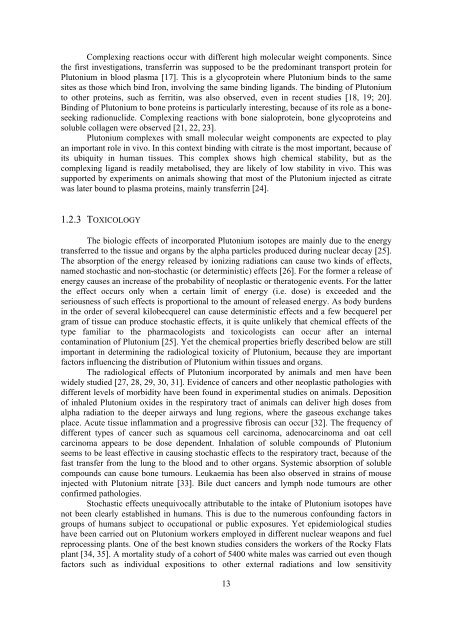Plutonium Biokinetics in Human Body A. Luciani - Kit-Bibliothek - FZK
Plutonium Biokinetics in Human Body A. Luciani - Kit-Bibliothek - FZK
Plutonium Biokinetics in Human Body A. Luciani - Kit-Bibliothek - FZK
You also want an ePaper? Increase the reach of your titles
YUMPU automatically turns print PDFs into web optimized ePapers that Google loves.
Complex<strong>in</strong>g reactions occur with different high molecular weight components. S<strong>in</strong>ce<br />
the first <strong>in</strong>vestigations, transferr<strong>in</strong> was supposed to be the predom<strong>in</strong>ant transport prote<strong>in</strong> for<br />
<strong>Plutonium</strong> <strong>in</strong> blood plasma [17]. This is a glycoprote<strong>in</strong> where <strong>Plutonium</strong> b<strong>in</strong>ds to the same<br />
sites as those which b<strong>in</strong>d Iron, <strong>in</strong>volv<strong>in</strong>g the same b<strong>in</strong>d<strong>in</strong>g ligands. The b<strong>in</strong>d<strong>in</strong>g of <strong>Plutonium</strong><br />
to other prote<strong>in</strong>s, such as ferrit<strong>in</strong>, was also observed, even <strong>in</strong> recent studies [18, 19; 20].<br />
B<strong>in</strong>d<strong>in</strong>g of <strong>Plutonium</strong> to bone prote<strong>in</strong>s is particularly <strong>in</strong>terest<strong>in</strong>g, because of its role as a boneseek<strong>in</strong>g<br />
radionuclide. Complex<strong>in</strong>g reactions with bone sialoprote<strong>in</strong>, bone glycoprote<strong>in</strong>s and<br />
soluble collagen were observed [21, 22, 23].<br />
<strong>Plutonium</strong> complexes with small molecular weight components are expected to play<br />
an important role <strong>in</strong> vivo. In this context b<strong>in</strong>d<strong>in</strong>g with citrate is the most important, because of<br />
its ubiquity <strong>in</strong> human tissues. This complex shows high chemical stability, but as the<br />
complex<strong>in</strong>g ligand is readily metabolised, they are likely of low stability <strong>in</strong> vivo. This was<br />
supported by experiments on animals show<strong>in</strong>g that most of the <strong>Plutonium</strong> <strong>in</strong>jected as citrate<br />
was later bound to plasma prote<strong>in</strong>s, ma<strong>in</strong>ly transferr<strong>in</strong> [24].<br />
1.2.3 TOXICOLOGY<br />
The biologic effects of <strong>in</strong>corporated <strong>Plutonium</strong> isotopes are ma<strong>in</strong>ly due to the energy<br />
transferred to the tissue and organs by the alpha particles produced dur<strong>in</strong>g nuclear decay [25].<br />
The absorption of the energy released by ioniz<strong>in</strong>g radiations can cause two k<strong>in</strong>ds of effects,<br />
named stochastic and non-stochastic (or determ<strong>in</strong>istic) effects [26]. For the former a release of<br />
energy causes an <strong>in</strong>crease of the probability of neoplastic or theratogenic events. For the latter<br />
the effect occurs only when a certa<strong>in</strong> limit of energy (i.e. dose) is exceeded and the<br />
seriousness of such effects is proportional to the amount of released energy. As body burdens<br />
<strong>in</strong> the order of several kilobecquerel can cause determ<strong>in</strong>istic effects and a few becquerel per<br />
gram of tissue can produce stochastic effects, it is quite unlikely that chemical effects of the<br />
type familiar to the pharmacologists and toxicologists can occur after an <strong>in</strong>ternal<br />
contam<strong>in</strong>ation of <strong>Plutonium</strong> [25]. Yet the chemical properties briefly described below are still<br />
important <strong>in</strong> determ<strong>in</strong><strong>in</strong>g the radiological toxicity of <strong>Plutonium</strong>, because they are important<br />
factors <strong>in</strong>fluenc<strong>in</strong>g the distribution of <strong>Plutonium</strong> with<strong>in</strong> tissues and organs.<br />
The radiological effects of <strong>Plutonium</strong> <strong>in</strong>corporated by animals and men have been<br />
widely studied [27, 28, 29, 30, 31]. Evidence of cancers and other neoplastic pathologies with<br />
different levels of morbidity have been found <strong>in</strong> experimental studies on animals. Deposition<br />
of <strong>in</strong>haled <strong>Plutonium</strong> oxides <strong>in</strong> the respiratory tract of animals can deliver high doses from<br />
alpha radiation to the deeper airways and lung regions, where the gaseous exchange takes<br />
place. Acute tissue <strong>in</strong>flammation and a progressive fibrosis can occur [32]. The frequency of<br />
different types of cancer such as squamous cell carc<strong>in</strong>oma, adenocarc<strong>in</strong>oma and oat cell<br />
carc<strong>in</strong>oma appears to be dose dependent. Inhalation of soluble compounds of <strong>Plutonium</strong><br />
seems to be least effective <strong>in</strong> caus<strong>in</strong>g stochastic effects to the respiratory tract, because of the<br />
fast transfer from the lung to the blood and to other organs. Systemic absorption of soluble<br />
compounds can cause bone tumours. Leukaemia has been also observed <strong>in</strong> stra<strong>in</strong>s of mouse<br />
<strong>in</strong>jected with <strong>Plutonium</strong> nitrate [33]. Bile duct cancers and lymph node tumours are other<br />
confirmed pathologies.<br />
Stochastic effects unequivocally attributable to the <strong>in</strong>take of <strong>Plutonium</strong> isotopes have<br />
not been clearly established <strong>in</strong> humans. This is due to the numerous confound<strong>in</strong>g factors <strong>in</strong><br />
groups of humans subject to occupational or public exposures. Yet epidemiological studies<br />
have been carried out on <strong>Plutonium</strong> workers employed <strong>in</strong> different nuclear weapons and fuel<br />
reprocess<strong>in</strong>g plants. One of the best known studies considers the workers of the Rocky Flats<br />
plant [34, 35]. A mortality study of a cohort of 5400 white males was carried out even though<br />
factors such as <strong>in</strong>dividual expositions to other external radiations and low sensitivity<br />
13












![{A1[]Sp - Bibliothek](https://img.yumpu.com/21908054/1/184x260/a1sp-bibliothek.jpg?quality=85)




